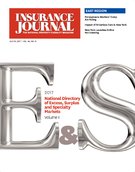New York Governor Andrew Cuomo in May signed a budget bill into law allowing self-driving and self-parking cars to be tested for one year on New York public highways.
Prior to this law going into effect, the technology was prohibited from being tested in New York because of a traffic law requiring all motor vehicles to be operated with at least one hand on the steering wheel, according to Stanley Zator, an attorney at New Jersey-based law firm Einhorn Harris, who recently spoke with Insurance Journal about the new legislation in New York and its impact on the ever-changing technology around driverless cars and automated vehicles.
Vehicles to be tested in New York are required be operated with a human driver in the driver seat and carry a minimum of $5 million in liability insurance coverage following the passage of the new law, Zator added.
In addition to the new legislation’s impact in New York, Zator also discussed possible personal injury laws associated with driverless cars and automated vehicles and how negligence lawsuits could change in the future as a result.
Insurance Journal: Could you talk about some of the main differences between true driverless cars versus automated vehicles?
Stanley Zator: There is a distinction between self-driving cars and driverless cars. Self-driving cars are not fully automated. They require a certain degree of human interaction, which may require a human driver being behind the wheel and performing certain tasks in order to get the vehicle started on a given roadway before switching to something like an autopilot feature. Driverless cars, on the other hand, are completely autonomous without the need of human intervention. I’ve often heard of them being referred to like something out of “The Jetsons.”
IJ: In terms of true driverless cars, what do you see as some of the main benefits?
SZ: I believe driverless cars can offer a number of benefits. The top three that stand out most to me involve safety, productivity and some environmental advantages. Reportedly, 95 percent of motor vehicle accidents result from human error. By removing humans from the equation, driverless cars have the potential to actually significantly reduce car accidents and the injuries that result from them. Driverless cars can also increase productivity for those that suffer from long commutes to work or experience significant traffic delays to where they’re traveling. Rather than being preoccupied by driving in gridlock traffic, the occupant of the autonomous vehicle can divert their attention away from driving and toward a more productive task that could make their lives more efficient. As far as the environment’s concerned, I think driverless cars have the potential to expand ride sharing and public transportation opportunities that could significantly reduce carbon emissions and result in a cleaner environment, which is actually something that, I think, is currently being done by way of a pilot program with selfdriving cars in Arizona.
IJ: On the opposite end of the spectrum, could you talk about some of the biggest challenges so far that you see driverless cars presenting?
SZ: A few challenges faced by driverless cars are definitely safety and cyber security, at least as it stands now. The technology for automated cars is still in the developmental stages, so there are a number of accidents involving driverless cars and self-driving cars that have occurred over the past few years. From what I understand, further development and testing is required in order to operate these types of vehicles in adverse weather conditions, as well as more complex environments such as New York City. Obviously, there are added elements in that type of environment, such as horsedrawn carriages, pedestrians and cars coming from every which way and direction. It’s something that’s a little bit more complex, and I’m not sure that the technology has caught up to that just yet. As it relates to cyber security, there’s a likelihood that driverless cars may be susceptible to hacking, which could result in vehicle theft among other crimes, as well as even terror related issues.
IJ: What are some of the challenges personal injury lawyers in particular may run into trying to keep pace with the technology around driverless cars?
SZ: In my opinion, the biggest challenge that personal injury law may face is the potential that a legitimately injured claimant may lose his or her day in court because it’s not economically feasible to pursue the claim. What I mean by that is that driverless cars may actually shift our notions of liability from traditional negligence suits against a human driver to products liability actions against the manufacturers of these types of cars, as well as the software developers, among countless other developments that are involved in the actual production of these vehicles. In other words, fault won’t be determined necessarily by human error, but a defect in the driverless car. Products liability cases, by their very nature, are very complex and costly. If the value of a given claimant’s injuries don’t justify the cost of pursuing those types of cases, that claimant may potentially be turned away because it doesn’t make good business sense for the attorney to pursue that case. It will definitely be interesting to see how the law accounts for this type of scenario and whether these types of plaintiffs may be forced to band together in some form of class action lawsuit to spread the risk and cost.
IJ: On April 5th of this year, the New York City legislature approved a bill permitting the use of autonomous vehicles on New York public highways, and it was signed into law in May by Governor Andrew Cuomo. What are some of the anticipated impacts that it might have in New York?
SZ: Governor Cuomo did, in fact, sign a budget bill into law allowing self-driving and self-parking cars to be tested for one year on New York public highways. These vehicles must be operated with a human driver in the driver seat, so they have to be self-driving cars. They must also carry a minimum of $5 million in liability insurance coverage. Prior to this law going into effect, this technology was actually prohibited from being tested in New York based upon a traffic law that required all motor vehicles to be operated with at least one hand on the steering wheel. As far as the impact on the state is concerned, I think Governor Cuomo is really hoping to create greater economic opportunities for New York-based companies to be further involved in the development of this type of technology. There’s also a push to develop alternative ride sharing and public transportation options, particularly if you’re looking down the road at New York City. In turn, you have taxi cab drivers and limo services who are undertaking their own efforts to ensure that they’re not becoming displaced by this type of technology. We can already see some economic and political ramifications that are occurring in New York.
IJ: With the passing of that legislation, what will personal injury lawyers need to keep in mind for the future?
SZ: It will be imperative for New York personal injury lawyers to become familiar with the ins and outs of the law that was recently passed by Governor Cuomo. It will certainly guide their fact-finding investigations if they find themselves in this circumstance of representing an individual that was injured by a self-driving car on a New York highway. I think moving forward, personal injury lawyers should always keep in mind that these changes in technology may result in significant changes to the law as well as the insurance industry, which will make it ever more important obviously to seek out continuing legal education opportunities, as well as engage in dialogue with their colleagues to best serve their clients.
IJ: We’ve spoken about how this may impact New York, but are other states expected to follow suit as well?
SZ: We’ve already seen a major push for testing in states outside of New York. Arizona, California, Pennsylvania and Florida come to mind, but I anticipate that this list will continue to grow as technology advances and vehicle safety increases.
IJ: To sum up everything we’ve talked about, what are some of the biggest opportunities and challenges regarding driverless cars to keep a close eye on going forward?
SZ: In short, the biggest advantages and challenges to keep an eye on will be, in my opinion, safety and cyber security. Once these issues can be resolved reliably to a satisfactory degree, I think you’ll see driverless cars integrated into society on a much wider scale.
Was this article valuable?
Here are more articles you may enjoy.


 Georgia Republicans Move to Scrap State Income Tax by 2032 Despite Concerns
Georgia Republicans Move to Scrap State Income Tax by 2032 Despite Concerns  Experian: AI Agents Could Overtake Human Error as Major Cause of Data Breaches
Experian: AI Agents Could Overtake Human Error as Major Cause of Data Breaches  Nearly Half of 100 Largest P/C Insurers Destroy Value: ACORD
Nearly Half of 100 Largest P/C Insurers Destroy Value: ACORD  Wildfires, Storms Fuel 2025 Insured Losses of $108 Billion: Munich Re Report
Wildfires, Storms Fuel 2025 Insured Losses of $108 Billion: Munich Re Report 



